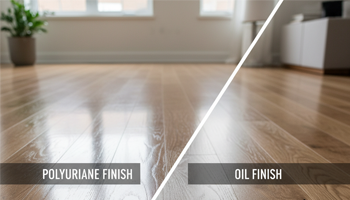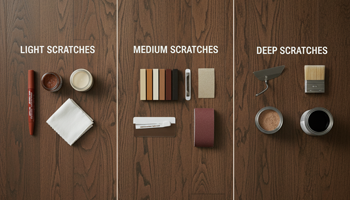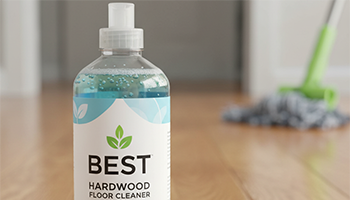Durability & Maintenance Comparison
If you’re comparing polyurethane vs oil finish for hardwood floors, you’re really choosing between a film-forming shield and a penetrating treatment. After installing and finishing thousands of square feet, here’s the no-spin, data-driven breakdown—plus what actually holds up in homes with kids, pets, and real life.
Understanding the Two Finish Systems
What Is Polyurethane (Film-Forming Protection)
Polyurethane creates a protective film on top of the wood. Think of it as a transparent armor layer that resists abrasion, moisture, and everyday spills. It’s available in water-based (waterborne) and oil-based (oil-modified) formulas and multiple sheens from matte to gloss. In practice, this topcoat simplifies daily cleaning and slows down visible wear in high-traffic areas.
In my projects, polyurethane is the “live-in” option: predictable results, easy maintenance, and fewer surprises when life gets busy.
What Is an Oil Finish (Penetrating Protection)
Oil finishes (including hardwax oils) penetrate the wood fibers and cure within the pores, leaving a very thin film or none at all. The wood looks and feels natural—texture-forward, low sheen, and high character. Because protection sits within the wood, these floors look beautifully matte and can be spot-repaired quickly.
The Core Difference: Surface Film vs Deep Penetration
- Polyurethane = surface film. Excellent abrasion resistance, easy to clean, higher initial build.
- Oil finish = penetration. Ultra-natural look, easy localized repair, but needs regular refreshing to maintain water and wear resistance.
Water-Based vs Oil-Based Polyurethane
Appearance: Crystal-Clear vs Amber Toning
- Water-based polyurethane stays crystal-clear, preserving natural or gray/white-washed tones without yellowing.
- Oil-based polyurethane adds a warm amber cast that deepens over time (beautiful on species like oak, but a mismatch on gray and white-washed floors).
Myth check: “Oil-based always looks richer.” True for warm tones; not for gray/bleached palettes where clarity is king.
Application & Drying Times (Same-Day Recoat vs Overnight)
From the field: premium waterborne systems allow 2–4 hour recoats and low odor, so a multi-coat job often fits into a single day. Oil-based typically needs overnight between coats and leaves a stronger odor while curing.
When I switched to top-tier waterborne, it cut jobsite downtime dramatically and kept households functional during projects.
Durability Spotlight: Bona Traffic HD vs Traditional Oil Poly
Here’s the big update many homeowners miss. Pre-2010, oil-based poly had a clear edge in wear. Modern 2-component waterborne systems Bona Traffic HD match or exceed traditional oil-based polyurethane in Taber abrasion and scuff resistance—without the ambering or extended cure times. That’s been my consistent, real-world finding across busy family homes.
VOCs & Indoor Air Quality
- Waterborne polys typically carry lower VOCs and faster odor dissipation, with many products certified for better indoor air performance.
- Oil-based polys have higher VOCs and stronger odor while curing.
Durability & Longevity Analysis
Abrasion Resistance: What Recent Results and Pros Show
If your goal is “which floor finish lasts longer,” the answer in 2025 depends on product tier more than chemistry alone. Premium waterborne (e.g., 2-component) holds up as long as or longer than many standard oil-based polys in scratch/abrasion tests.
In my experience, the difference between budget and premium is night and day. Pay for the good stuff once; enjoy it daily.
Lifespan Expectations (10–15 Years for Poly; Oil Depends on Care)
- Polyurethane (properly maintained): 10–15 years before a full sand is likely—often longer with periodic screen-and-recoats.
- Oil finish life varies widely. With regular care (soaps and re-oiling), you can postpone a full sand for a very long time, but it’s an active maintenance journey.
High-Traffic Stress Test: Kids, Pets & Kitchens
For kids, dogs, rolling chairs, and busy kitchens, polyurethane’s film hardness slows visible wear. Oils can still win on stealth repairs (you’ll fix small spots fast), but frequent refreshes are part of the deal.
Family-Friendly Performance
Day-to-day, waterborne poly balances durability, low odor, and quick return to service—ideal for families. Oil’s beauty is undeniable, but plan for upkeep.
Daily Maintenance Requirements
Polyurethane: Sweep, Vacuum, Damp-Mop
- Routine: Dust mop/sweep/vacuum; damp-mop with a pH-neutral cleaner.
- Avoid: Steam mops, harsh solvents, or very wet mopping.
Oil Finish: Specialty Soaps & Periodic Re-Oiling
- Routine: Manufacturer’s soap/cleaner to nourish the finish.
- Periodic: Re-oiling to replenish protection, especially in traffic lanes.
Contractor secret I keep seeing: oil-based (poly) is often pushed because it’s faster for the contractor to apply and leave. High-quality waterborne demands more precision—but it’s actually easier for the homeowner’s life afterward.
Weekly Time Investment: Side-by-Side
- Poly: Basic cleaning, low time commitment.
- Oil: Similar daily cleaning plus periodic care steps; overall higher annual time.
Long-Term Care & Refinishing
Polyurethane: Screen & Recoat vs Full Sand-and-Refinish
A screen-and-recoat (light abrading + new topcoat) refreshes sheen and protection without sanding to raw wood—preserving thickness for future refinish cycles.
Oil Finish: Spot Repairs and Whole-Floor Refreshes
Local touch-ups are oil’s superpower. When overall luster drops, a maintenance oil brings the floor back—no sanding required unless damage reaches raw wood.
10-Year Cost of Ownership: Budget Comparison (Illustrative)
Assumptions (for comparison only; markets vary):
- Waterborne premium poly: higher upfront; screen-and-recoat every 3–5 years.
- Oil finish: lower upfront (often), but regular care products and re-oils add up.
Rule of thumb I give clients: For households that truly use their floors, polyurethane tends to save money over a decade by stretching intervals between major service events.
Aesthetic Considerations
Natural Matte vs Glossy Sheen
- Oil finish: naturally matte, tactile, “organic.”
- Poly: from extra-matte to gloss. My go-to for a natural vibe is waterborne satin or extra-matte—reads like bare wood with real-world protection.
How Each Finish Ages (Ambering, Patina, Wear Patterns)
- Oil-based poly warms/ambers over time; lovely on warm stains, less ideal on cool/gray schemes.
- Waterborne poly stays clear; minimal color shift.
- Oil finishes develop a gentle patina; micro-wear can actually enhance character—if you maintain it.
Gray & White-Washed Floors: Avoiding Yellowing
Do not use oil-based poly over gray or white-washed floors if you want to keep that tone. Use waterborne systems designed to lock in color (many have “anti-amber” formulas) or compatible sealers recommended by NWFA.
European vs American Style Preferences
Europe leans low-sheen, oil/hardwax oil looks. The U.S. remains poly-heavy, but extra-matte waterborne finishes are closing that style gap fast.
Scratch & Damage Repair
Polyurethane: Visible White Scratches (Harder to Blend)
Because scratches disrupt the film, they may look whitish and are harder to “spot-blend” invisibly. Small fixes exist, but larger issues often call for a screen-and-recoat.
Oil Finish: Easy Spot Touch-Ups
For heels, pet claws, or chair rubs, a quick spot repair with maintenance oil often makes marks disappear with minimal fuss.
Which Shows Wear More Obviously?
- Poly hides uniform micro-wear well but shows isolated scratches.
- Oil hides isolated marks better but reveals overall dulling unless refreshed.
Best Applications for Each Finish Type
When to Choose Polyurethane (High-Traffic, Low-Maintenance)
- Kids, pets, rentals, kitchens, hallways.
- Want the longest interval between major maintenance.
- Prefer clear or non-ambered look (especially on gray/white-washed).
When to Choose Oil (Character, Natural Look, Easy Repairs)
- Design-led spaces, low to moderate traffic.
- You value touch-up friendliness and organic texture over maximum film hardness.
Commercial Insights: Restaurants & Retail
Heavy traffic with daily cleaning skews toward premium waterborne poly for film toughness and speed. Boutiques and galleries sometimes pick hardwax oil for the tactile look with planned maintenance cycles.
Make the Right Choice for Your Home
Lifestyle Assessment Checklist
- How many kids/pets?
- Do chairs roll? Heavy kitchen traffic?
- Is odor/IAQ a concern?
- Gray/white-washed color that must stay true?
- Preference for hands-off vs hands-on maintenance?
Budget: Upfront vs Long-Term
- Pay more upfront for premium waterborne and recoup with longer intervals.
- Pay less upfront for oil finish, budget for regular refreshing.
Warranty Considerations
Follow manufacturer/NWFA guidelines for cleaners, pads, and maintenance intervals to keep warranties intact.
Maintenance Timeline
Day/Week/Month/Year Planner — Polyurethane
- Daily/As needed: Dust mop/vacuum; spot-clean spills.
- Weekly: Damp-mop with pH-neutral cleaner; floor protectors under chairs.
- Quarterly: Inspect traffic lanes; address sliders/felt pads.
- Every 3–5 years: Screen-and-recoat to reset wear and sheen (usage-dependent).
Day/Week/Month/Year Planner — Oil Finish
- Daily/As needed: Dust mop/vacuum; spot-clean with manufacturer soap.
- Weekly: Damp-mop using the recommended cleaner (no generic detergents).
- Quarterly/Semi-annual: Maintenance oil or refresher on traffic lanes.
- As needed: Whole-floor refresh when luster/repellence drops; full sand only if damage is deep.
If you asked me “which floor finish lasts longer?” in 2025, I’d answer: premium waterborne polyurethane can last as long or longer than traditional oil-based poly—while staying clearer, curing faster, and keeping indoor life saner. My rule of thumb: polyurethane to live in, oil to show off. And if you love that near-raw look? Choose waterborne poly in satin or extra-matte for the best everyday compromise.
Understanding the trade-offs between oil and polyurethane finishes is easier through the Hardwood Floor Care framework, and tied to sanding frequency discussed in Refinishing Hardwood Floors.
FAQs
Does water-based polyurethane last as long as oil-based?
With top-tier waterborne systems (e.g., 2-component), yes—in my experience they match or surpass many oil-based polys in abrasion resistance.
Is Bona Traffic HD really that durable?
It’s been a game-changer on busy households I service—high abrasion resistance, fast recoat, and a clear, modern look Bona.
What’s the best finish for homes with dogs and kids?
Premium waterborne polyurethane, extra-matte or satin, for toughness and easy cleaning.
How often to refinish polyurethane vs oil-finished floors?
Poly can go years with screen-and-recoats; oil needs regular refreshing and occasional re-oiling.
Can I switch from an oil finish to polyurethane?
Usually requires sanding to bare wood to ensure adhesion. Always follow NWFA best practices.
Why avoid oil-based polyurethane on gray-stained floors?
Ambering will shift the color warmer over time. Choose waterborne to preserve gray/white-wash.
Currently viewing
Polyurethane vs Oil Finish Floors

Repair Scratches in Hardwood Floors
How to Repair Scratches in Hardwood Floors: Complete Guide by Severity Level If you’re staring…
Refinishing Hardwood Floors
Sand & Refinish vs Screen & Recoat — Complete Comparison Guide If you’re weighing screen…
Best Hardwood Floor Cleaner
pH-Neutral & No-Residue Options TL;DR (buyer’s snapshot): For most homes, a pH-neutral hardwood floor cleaner…
Hardwood Floor Care Masterclass
Complete Guide by Wood Species & Finish If you want hardwood floor care by species…
Quick Comparison Table
| Factor | Water-Based Polyurethane | Oil-Based Polyurethane | Oil Finish / Hardwax Oil |
|---|---|---|---|
| Look | Clear, preserves gray/white-wash | Amber tone, deepens over time | Ultra-natural, matte, texture-forward |
| Dry/Recoat | 2–4 hrs, low odor | Overnight, stronger odor | Fast spot repairs, full refresh varies |
| Durability | High (premium 2-K = top tier) | High (classic benchmark) | Moderate–High with upkeep |
| Maintenance | Low; easy cleaning | Low–Moderate | Active (soaps, re-oils) |
| Best For | High-traffic, families, clarity | Warm tones, traditional looks | Design-driven, easy spot repair |
| Gray Floors | Recommended | Not recommended (ambering) | Compatible if maintained |




